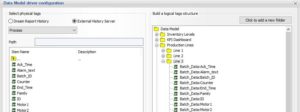In today’s fast paced and lean automation environments, employees need decision support information as quickly as possible. Downtime is expensive. Agility in production can be the difference in your delivery of product or your competitor getting an order. For those and many other reasons, access to information needs to be fast and easy.
In many organizations, access to information is through a data gatekeeper, the one that knows the technology infrastructure, the storage systems and the data identifications (Tag Names). You may want the production rates when Product XYZ was running and the line went down. To your gatekeeper, that’s a request for P13_M6_Rate.cv from your historian over a period defined by a Product XYZ lookup from a SQL Batch Table that results in the time from 4/4/2016 12:34:11 to 4/4/2016 14:23:04. It is complicated and that’s why process engineers get lots of requests for data. “Put that data into an Excel Spreadsheet for me” is a common request.
 This example highlights several challenges that can go away with the installation of a Self Service Solution such as Dream Report.
This example highlights several challenges that can go away with the installation of a Self Service Solution such as Dream Report.
- The example requires a lookup of one item to define the period of another. This can be done automatically within Dream Report. It is batch aware and batches are any condition with a variable start and end time, so we are talking about operations such as those from backup generators, filter flush operations, equipment startups and not just a traditional chemical, pharmaceutical or food/beverage batch application.
- The example shows how cryptic tag name conventions are in most automation systems. Sure, newer systems offer S95 models. But most automation systems are still based on flat tag spaces with limited tag lengths. That forced cryptic naming conventions and that makes data hard to retrieve. In addition, your key variables are hidden in an Ocean of Tags, the ones you need for automation but not necessarily for data analysis. Typically, only 10 to 15% of Tags in a system (historian) would ever be used for reporting or analysis. Dream Report enables you to select the tags that should be of value to users, organize them in an S95 hierarchy (or any other grouping that you wish) and rename them for user friendliness. Later on, those tag models can be applied to a user based web portal.
- Access to data usually involves Client Access Tools, specific to the system with the data. For a historian, that could be Excel client access tools from a particular vendor. For a SQL Database, that could mean using SSRS or other tools to query your data for the desired results. Dream Report offers user friendly connectivity to all your systems. It is your one common solution for accessing all your systems. Dream Report connections are set up once by your domain administrator or process engineer and after that, users have easy access to the wealth of information that those disparate systems can deliver. That information can be incorporated into reports and dashboards, defined by your users, not by your data scientists or domain administrators. Gone are the days of asking others to get your information.
- It isn’t just about generating reports. Reports are great if you want repetitive access to a set of data, but most times, especially for troubleshooting, you need ad-hoc access to your data. You want to browse the data that you are allowed to see, you’ll want to pan and zoom, search and sort and drill down into additional views as necessary to access information to support your decisions. When you find what you want, press a button and save that data to Excel for further analysis. Dream Report delivers all that through its user based and mobile aware web portal. Both local and domain based security ensures that the right people have access to the right information when they want it.
All these features enable Dream Report to be your “Self Service Solution”, empowering your organization to access your data and create the information they need to make better decisions. Just one more reason Dream Report needs to be the next addition to every automation system.
